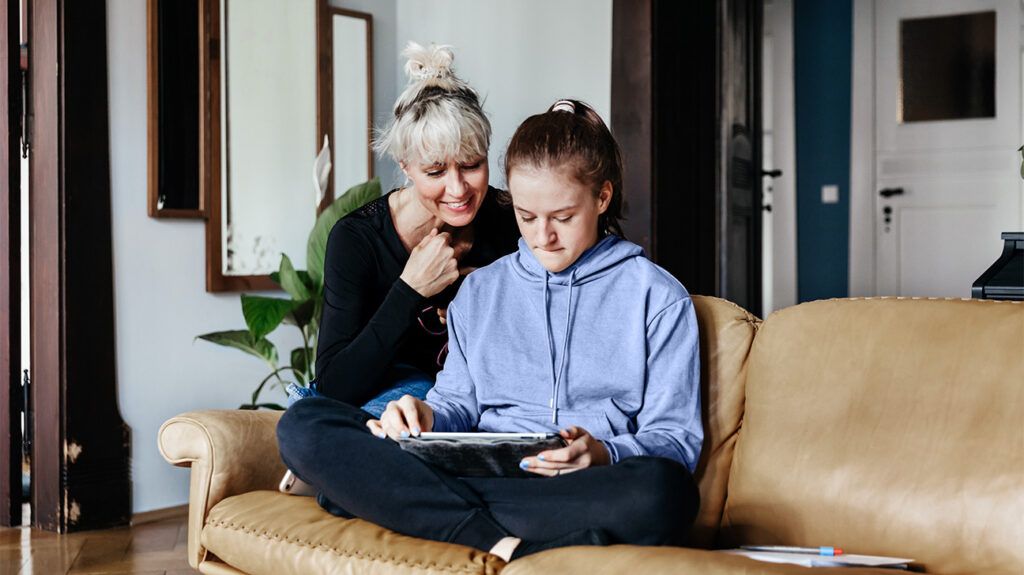OCD can make daily life overwhelming for children, but a supportive home environment can make a significant difference.
Obsessive-compulsive disorder (OCD) is a mental health condition consisting of intrusive, repetitive thoughts and behaviors that can significantly disrupt a child’s life. These challenges can leave children feeling overwhelmed and families wondering how to help a child with OCD at home.
Parents and caregivers are critical in creating a stable and supportive environment where children feel safe addressing their symptoms.
By understanding OCD, practicing patient and empathetic communication, and adopting strategies that promote resilience, families can help their children cope with daily challenges while building confidence and coping skills.

OCD can deeply impact a child’s daily life, making even minor or routine tasks feel overwhelming. The condition can lead to increased anxiety, frustration, or guilt, which can interfere with school, friendships, and family dynamics.
A supportive home environment can help children manage their symptoms and become more confident.
Parents and caregivers are critical in this process. By educating themselves about the condition, creating consistent routines, and fostering a sense of safety, they can empower the child to tackle challenges in manageable steps.
A supportive approach extends beyond addressing symptoms — it also involves nurturing emotional resilience and self-esteem.
Open and compassionate communication helps children feel understood and reduces their isolation. Seeking professional help through therapy while implementing strategies at home provides a balanced approach to their care.
What is OCD?
OCD, or obsessive-compulsive disorder, is a mental health condition that
To reduce this distress, a child may engage in repetitive actions or mental rituals known as compulsions, such as checking, counting, washing, or seeking reassurance. These behaviors may provide temporary relief but can reinforce the cycle of anxiety over time.
For children, OCD can interfere with essential aspects of their lives, including their education, relationships with peers, and family interactions. The condition may lead to avoidance of certain situations or tasks, difficulty concentrating, or emotional outbursts concerning interrupted compulsions.
Without intervention, OCD can significantly affect a child’s quality of life.
Supporting a child with OCD requires patience, consistency, and an understanding of their unique needs. Here are some ways to reduce stress and promote positive coping strategies:
- Create a structured environment: Establishing clear and consistent daily routines can help a child feel more secure and in control. Predictable schedules reduce uncertainty, which can lessen anxiety and minimize the need for compulsive behaviors. For example, regular meal times, homework hours, and bedtime routines can provide a sense of stability.
- Set realistic expectations: Recovery from OCD is a gradual process. Focus on small, achievable goals, such as delaying a compulsion by a few minutes or trying to complete a task without rituals. Avoid pressuring the child to stop their behaviors all at once, as this can lead to frustration or resistance. Celebrate incremental progress, emphasizing effort rather than perfection.
- Offer positive reinforcement: Acknowledge and praise the child’s efforts to manage their OCD symptoms, no matter how minor the achievement may seem. This could include recognizing when they resist a compulsion or openly discuss their feelings. Positive reinforcement builds confidence and encourages the child to engage in healthier behaviors.
- Encourage facing fears head-on: Support the child in gradually confronting situations or thoughts that trigger their OCD, a process known as exposure. This can help in a controlled and safe manner, ideally under the guidance of a therapist. For example, if the child fears touching certain objects, encourage them to take small steps, such as holding the object briefly, to reduce anxiety over time. Facing fears helps build resilience and reduces reliance on compulsions.
Effective communication is crucial when supporting a child with OCD. Understanding how to approach conversations about the condition can help the child feel validated. Use the following approaches:
- Listen actively: Give the child your full attention and let them express their feelings without judgment.
- Acknowledge their fears: Avoid minimizing or dismissing their worries. Instead, reassure them that their feelings are valid.
- Use clear, supportive language: Talk openly about OCD using age-appropriate terms, emphasizing that it is a manageable condition.
Understanding OCD is essential for both the child and their caregivers. Education may include:
- Learning together: Explore resources like books or online materials to develop a shared understanding of OCD.
- Explaining the brain’s role: Teach the child that OCD symptoms result from how the brain processes thoughts and fears, which can help reduce stigma.
- Introducing coping strategies: Work with the child to practice techniques such as mindfulness or deep breathing to help manage anxiety.
Professional help can be necessary to manage OCD effectively. Evidence-based therapies and additional resources can support a child’s progress.
Therapeutic options include:
- Cognitive-behavioral therapy (CBT): This approach, particularly exposure and response prevention (ERP), is highly effective in treating OCD.
- Medication: In some cases, medication prescribed by a healthcare professional can complement therapy to reduce symptoms.
- Support groups: Joining peer or family support groups can help normalize the experience and provide a sense of community.
Supporting a child with OCD is challenging, but organizations and support groups offer resources to assist:
- International OCD Foundation (IOCDF): IOCDF is a leading organization dedicated to providing up-to-date education and resources, strengthening community engagement worldwide, delivering quality professional training to clinicians, and funding groundbreaking research.
- Our Mental Health: Our Mental Health provides information on local OCD support groups and online communities, offering a safe space for individuals to connect and share experiences.
With the right support, children with OCD can learn to manage their symptoms and thrive.
Parents and caregivers should aim to create a supportive home environment, communicate effectively, educate themselves and the child about the condition, and seek professional help.
By working together, families can help children with OCD build the tools needed for long-term well-being.


